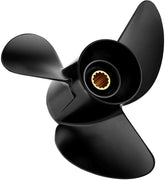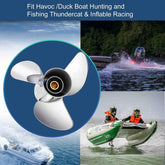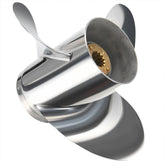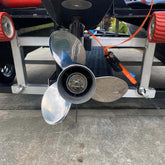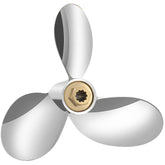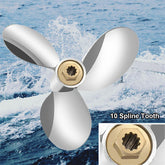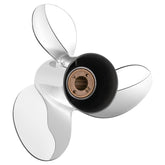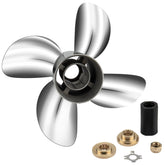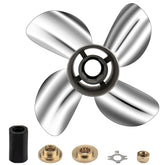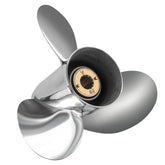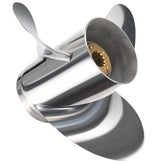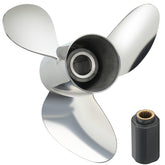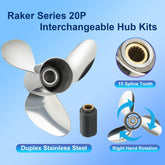Mercury Boat Propeller Alternatives: Affordable Stainless & Aluminum Props That Fit Mercury, Yamaha, Honda & Volvo
I write this as a propeller technician who spends more time on ramps and on the water than behind a desk. If your goal is simple and practical — get a prop that really fits, performs for how you actually use the boat, and does not cost an arm and a leg — read on. This is a conversion-focused, no-nonsense guide that walks you from how to confirm fitment through real on-water testing and straight to ordering the right prop on vifprop.com.
We are not Mercury, Yamaha, Honda or Volvo official. We manufacture compatible props that match common spline and hub standards and gearcase codes used by those brands. That means you can get a value stainless or aluminum replacement that fits and performs, but only if you pick the right SKU and test it the right way. Read the fit checklist, follow the testing workflow, then place your order at vifprop.com.
Why a non OEM prop might be the smartest purchase and when to stick with OEM
Most boat owners think OEM equals safe and easy and that is usually true. OEM fitment is reliable and supported by dealers. But there are practical reasons a carefully chosen aftermarket or factory direct prop is often the better move.
Cost to test. OEM stainless can be so expensive that owners avoid testing different pitches or blade counts. Factory direct stainless narrows that gap so you can afford to buy a baseline plus a one inch lower pitch and a four blade option. That makes iterative tuning realistic.
Speed to ship and returns. U.S. warehousing and a simple returns policy mean less downtime. VIF keeps U.S. stock for fast shipping and local returns.
Choice variety. Aftermarket lines include cleavers, high rake and cupped blades that OEM catalogs do not always list for every gearcase. Some hulls need non standard geometry to behave optimally.
Practical replacements. For rental fleets, schools and heavy users, having an affordable aluminum spare and a reliable stainless daily prop is a better risk strategy than one expensive OEM blade.
When to stay OEM. If your boat is under a dealer warranty that requires OEM parts for coverage, or you need dealer service continuity and zero risk plug and play replacements, stay OEM. Otherwise, a compatible factory direct prop is a smart and practical choice.
Fit checklist, do not buy until you confirm these facts
A product page that says fits Mercury is not good enough. Confirm these five facts before you order.
-
Engine make, model and year written exactly as on the transom tag.
-
Gearcase code from the transom tag, because different gearcases use different splines and hubs.
-
Spline count and hub type, such as Flo Torq style insert or solid splined bore. Verify the product lists the spline count and hub compatibility.
-
Rotation, which means right hand, left hand or counter rotating. Do not assume twins are the same.
-
Washer and thrust plate sequence, because order matters and a wrong sequence can cause hub slip and premature wear.
If you cannot read the transom tag, pull the prop, photograph the hub and splines, and send those photos to the seller before buying. That avoids returns and downtime.
How we build reliability into the product offering at vifprop.com
When you order from vifprop.com expect these quality signals because they matter on the ramp.
CNC machined finishing ensures tight pitch and diameter tolerances and reduces surprises between two nominally identical props.
Dynamic balancing reduces vibration for every stainless prop we ship.
Corrosion testing and salt spray quality control improve life in marine environments.
U.S. warehouses provide fast shipping and easier returns.
A 180 day manufacturing warranty covers defects while explaining service options for strike damage.
Clear SKU fitment matrices make it easy to pick the prop that lists your engine model and gearcase code.
Those are not marketing buzzwords. They are the differences that matter when you need a part that fits.
Technical facts that determine whether a prop will work for you
These are the shop rules I use when helping an owner dial in a prop. Commit them to memory and use them on test day.
Pitch in inches is the primary tuning lever, because it determines whether the engine will reach its recommended wide open throttle RPM under your usual load.
Diameter in inches governs low end thrust and cavitation margin. Bigger diameter moves more water per revolution.
Blade area and blade count trade top speed for bite. More blade area provides better hole shot and planing under load, while fewer blades reduce drag for top speed.
Cupping is the small lip on the trailing edge that increases low end bite and resists ventilation.
Rake is tip tilt that influences bow lift, which helps certain hulls break onto plane earlier.
Slip is the practical metric that quantifies pitch match. Use it with the WOT RPM band to make decisions.
If a replacement prop does not bring WOT RPM into the correct band for your loaded boat, it is the wrong pitch no matter the brand name.
Two formulas for your phone, real data not guesswork
Paste these into your calculator and use them on test day.
Theoretical speed in miles per hour equals pitch in inches times RPM divided by 336.
Slip percentage equals one minus GPS speed divided by theoretical speed times 100.
For planing hulls target about 10 to 25 percent slip. Use this number with WOT RPM to decide on pitch and blade area.
On water testing workflow used by pro tuners, follow it exactly
This sequence avoids guesswork and costly returns.
Prepare the boat by removing barnacles, setting trim tabs as you normally run and filling the fuel tank to the typical level.
Warm the engine to operating temperature because cold running numbers are misleading.
Run two to three wide open throttle passes in the same calm conditions and average the GPS and tachometer readings.
Compute theoretical speed and slip using the formulas above.
Interpret the results.
If WOT RPM is below the manufacturer recommended band the pitch is too tall, drop pitch one inch or two and retest.
If WOT RPM is above the band the pitch is too small, increase pitch and retest.
If the boat will not plane but RPM is in the band increase blade area by switching to a four blade or a cupped three blade.
Iterate by testing one inch changes and a blade count swap until WOT RPM, slip and the planing feel are right.
Do the tests with your normal load, because empty boat testing often misleads.
Starter prop recommendations and orderable starting points
These are practical starting picks. Always select the SKU on vifprop.com that explicitly lists your engine and gearcase code.
For five to fifteen horsepower kickers start with eight inch by eight inch three blade aluminum.
For twenty to forty horsepower runabouts start with nine inch by ten inch three blade aluminum.
For fifty to ninety horsepower boats try eleven and a half inch diameter by fifteen inch pitch stainless as a baseline, with an aluminum spare and a four blade option to test.
For one hundred fifteen to one hundred fifty horsepower try fourteen inch by nineteen inch stainless three blade for speed and a four blade for loaded planing.
For one hundred seventy five to three hundred plus horsepower pick fifteen to seventeen inch diameter props with nineteen to twenty five inch pitch, testing cleavers and high rake options for high RPM runs.
If budget allows order the OEM baseline and one inch lower pitch or a four blade variant so you can iterate on the water quickly.
Aluminum versus stainless explained by a tech
Pick based on mission rather than marketing.
Aluminum cost is low, it bends on impact which often protects the gearbox, and it is good as a spare prop for shallow water.
Aluminum drawbacks include thicker blade sections that reduce peak efficiency and higher susceptibility to galvanic corrosion if not maintained.
Stainless allows thinner, more hydrodynamic blade sections which yield real top speed and cruise efficiency gains. Stainless retains its edge longer.
Stainless drawbacks include higher upfront cost and the tendency to transmit impact energy to the lower unit. Factory direct pricing makes stainless testing more realistic.
A practical combination is stainless as your daily prop and an aluminum spare for risky launches.
Blade choices that change real world performance
Three blade props offer the highest potential top speed for a given pitch and diameter and are the baseline for light loads and performance boats.
Four blade props increase blade area, improving hole shot and planing when heavily loaded, with a small top speed tradeoff. They are a top choice for pontoons, tritoons, family boats and towing.
Cleavers and high rake three blade props are for high speed, high RPM runs and require correct gearcase clearance and gearing.
If your boat is slow to plane under load and WOT RPM is inside the engine band switch to a four blade and retest. You will usually plane faster and see better usable speed.
Prop hub systems and common buyer traps
Common mistakes I see in the shop include ordering a prop that lists fits Mercury but does not list the gearcase code, getting the spline count wrong, ignoring washer and spacer sequence and assuming rotation direction.
Do this before buying. Photograph the spline and hub, and copy the gearcase code. Use those facts to match the SKU on the product page.
Diagnostic playbook for strikes, spun hubs, bent blades and lower unit damage
If you strike something stop the engine and shift to neutral immediately.
Inspect and photograph the blades, hub, splines and lower unit. Photographs speed up shop estimates and warranty claims.
Check lower unit oil for metal flakes or milky discoloration. If either is present do not run the engine and tow the boat to a shop.
Symptoms and likely causes.
Engine revs but boat will not move points to a spun hub or stripped splines.
Vibration at cruise speed points to a bent blade or imbalance.
Grinding noises and metal in the oil point to gearset or bearing failure.
Loss of top speed with normal RPM can be blade deformation or heavy fouling.
DIY triage includes removing the prop to inspect the elastomeric hub and splines, replacing the hub insert if shredded, checking shaft straightness on a bench and measuring prop runout with a dial indicator. Small bends on aluminum props can often be straightened and rebalanced.
If splines are stripped, the shaft is bent, or stainless is cracked stop and call a professional.
Typical cost ranges are hub insert kits fifteen to sixty dollars, aluminum prop straightening and dynamic balancing thirty to eighty dollars, stainless replacements two hundred to seven hundred dollars and lower unit rebuilds five hundred to three thousand five hundred dollars depending on scope.
Keep a spare aluminum prop and a hub kit in your trailer to avoid weekend ruining failures.
How factory direct manufacturing changes the tuning game
Historically stainless iterations were expensive. Factory direct manufacturing changes that with lower stainless pricing often thirty to fifty percent below OEM on comparable SKUs, CNC finishing and dynamic balancing for consistency, and U.S. warehousing plus a one hundred eighty day warranty for faster shipping and lower return friction.
For tuners such as tournament anglers, fleet managers and rental operators buying several stainless test props and iterating on the water is the fastest route to a tuned setup and now it is affordable.
Using manufacturer prop selector tools the right way
Manufacturer selectors are starting points not final answers.
Use Mercury and Yamaha selectors to find the OEM baseline for your engine and boat type. Record stock diameter, pitch and blade count and note the gearcase code.
Order the baseline for guaranteed fitment and also order one inch different pitch or a different blade count. Test both with your normal load.
Select the prop that lands WOT RPM in the recommended band while giving acceptable slip and planing behavior.
Your real load and hull conditions are the final judges.
Conversion oriented buying checklist, exact steps to order on vifprop.com
Pull the current prop and photograph the hub and splines or copy the transom tag data.
Go to vifprop.com and use the compatibility matrix on the product page.
Confirm engine model, gearcase code and spline count match the SKU. Use live chat and upload photos if you want confirmation.
Add the baseline prop plus one inch lower pitch or a four blade variant to the cart and add an aluminum spare for shallow water if needed.
Choose U.S. warehouse shipping at checkout for fastest delivery.
When the props arrive follow the on water testing workflow. Keep packaging in case you need to return under the warranty and return policy.
Ordering two props up front saves time and reduces multiple returns.
Frequently asked questions answered by a prop technician
Will a VIF prop damage my Mercury lower unit? Not if you select the correct SKU that matches the gearcase code and spline count. Damage occurs from impact, wrong washer order and running with contaminated oil, not from a properly matched prop.
How fast will I get it? Choose U.S. warehouse shipping at checkout. Most orders ship same or next business day and delivery times are shown at checkout.
What if I order the wrong prop? VIF has a clear returns policy and a one hundred eighty day manufacturing warranty. Keep the packaging and document fitment attempts. Use live chat to get quick assistance.
Can I test a stainless and return the one I do not want? Yes. Keep the prop unused in its packaging and follow return instructions on the product page.
Does VIF support Flo Torq type hubs and common Yamaha splines? Yes. Each prop SKU lists hub compatibility including Flo Torq style inserts or splined bore and spline count. Confirm your engine and gearcase code before ordering.
Final expert checklist, order test and be confident
-
Photograph your transom tag and old prop hub.
-
Confirm engine model and gearcase code.
-
Order the OEM baseline and one inch lower pitch stainless or a four blade variant plus an aluminum spare at vifprop.com. Use U.S. warehouse shipping.
-
Run the on water test workflow with your normal load by doing two to three wide open throttle passes and compute slip.
-
Keep the packaging and photos until you are satisfied and use support chat if anything looks off.
-
Keep a spare prop and a hub insert kit on the trailer to avoid weekend failures.
If you want to learn more about how our boat propellers are produced and understand the capabilities of our factory, you can refer to this article: https://vifmarine.com/how-boat-propellers-are-manufactured/


